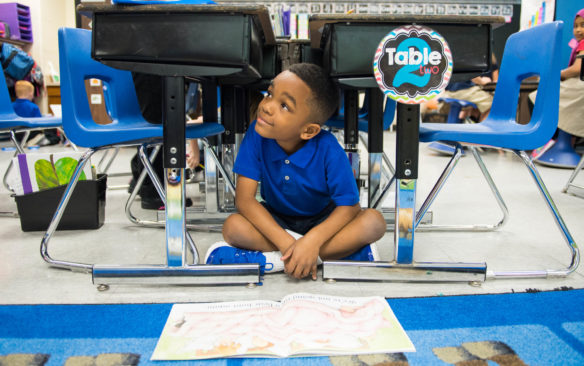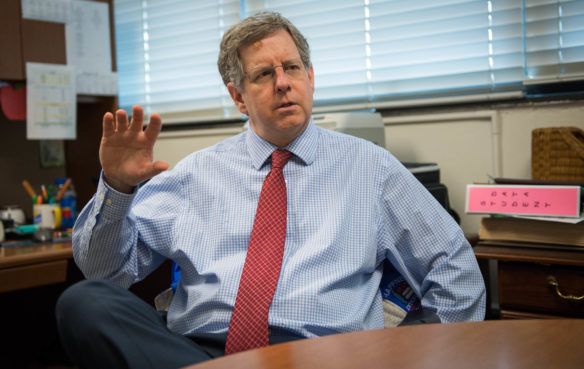
Jackson White, a 1st-grader at Schaffner Traditional Elementary, reads a book under a desk during literacy center time in Sarah Dickinson’s class. The Jefferson County school was one of five Kentucky public schools to be named a 2016 National Blue Ribbon winner.
Photo by Bobby Ellis, April 18, 2017
By Brenna R. Kelly
Brenna.kelly@education.ky.gov
When Sarah Dickinson told her 1st-grade students to line up for lunch, the 5- and 6-year-olds quickly and silently formed a line at the door.
Dickinson didn’t have to remind them to be quiet, tell anyone to keep their hands to themselves or remind them to stand in a straight line.
From their very first day at Schaffner Traditional Elementary, students learn the “5 Ss” – Silent, Straight, Side hands, Shirts tucked, Shoes tied.
“They all know it,” said 4th-grade teacher Sheryl Brown, who has been at the Jefferson County magnet school for 18 years. “We try to do that uniformly throughout the building so that every year we don’t have to go over it again.”
That uniformity is part of the culture at the kindergarten through 5th-grade school. All teachers have the same high expectations for academic success and set the same standards for behavior.
“It’s just very structured,” Brown said. “I think that’s one of the key factors to our success here.”
This school year, Schaffner was named a 2016 National Blue Ribbon School by the U.S Department of Education. The school was one of five Kentucky public schools to receive the honor, which is based on student achievement and other research-based indicators of quality.
“Our students were thrilled because they had been working hard,” said Phil Poore, who has been Schaffner’s principal for the past 10 years.
For the past four years, Schaffner has been named a Distinguished school under the state’s accountability system.
Students who live in the area designated for the school can apply and are chosen in a random drawing, Poore said. Schaffner is one of four traditional elementary schools in the county. Jefferson County’s traditional program, which also includes middle and high schools, places an added emphasis on academic standards, proper conduct, citizenship and the teaching of self-discipline.

Phil Poore, principal of Schaffner Traditional Elementary School, is one of only two principals to have led the school since it adopted the traditional model more than 25 years ago. Poore said he chooses to stay at the school because of its family atmosphere.
Photo by Bobby Ellis, April 18, 2017
“We have high standards for behavior, academics, dress and parent involvement,” Poore said. At Schaffner, students wear uniforms of solid-colored polo shirts and blue or khaki shorts, pants or skirts.
Each traditional elementary has its own attendance zone. Schaffner’s area includes Shively and central and southeastern Jefferson County, which allows for a diverse student population. Nearly 50 percent of Schaffner’s students qualify for free and reduced-price meals and 36 percent of its students are minorities.
When students are accepted, parents sign a commitment code that lists the parental expectations and details what the parents can expect from the school, such as weekly updates on their child’s progress.
Because parents choose the school, few students leave until they go on to middle school, Poore said. Student turnover in 2014-15 was 1 percent, according to the school’s Blue Ribbon application.
“That allows us to develop some really nice relationships with kids in terms of their emotional needs and their developmental needs,” he said.
Likewise, few teachers leave the school until they retire, he said.
“It’s a very stable, predictable, consistent environment,” Poore said.
Dickinson started her teaching career at Schaffner three years ago and doesn’t plan to leave.
“I like that the kids are really focused and they get a lot of parent support at home,” she said. “It’s very easy to engage them in learning. They are very eager and active and ready to learn every day.”
On a recent morning in Dickinson’s classroom, the 1st-grade students were scattered around the room reading while Dickinson helped a group of students using guided reading.
Then it was time for the Phonics dance. Dickenson got out her “magic sounds sprinkles” and sprinkled the glitter into the students’ hands.
“Make these firsties smart, help them to tell their sounds and letters apart,” the students sang as they smoothed the glitter into their hair.
Then they sang the song, a mix of moves, rhymes and chants designed to help students break down words into “hunks and chunks,” Dickinson said. The students sang “when you see a ph you don’t say a ph, you say fa, fa,” while holding pretend phones to their ears.
Dickinson learned the research-based program as a student teacher and saw how it helped her students make connections between reading and writing. Each week Dickinson’s students learn a new “chunk” and motion that goes with it.
“They are really excited and motivated to learn the chant for that chunk and to move their bodies with the motions,” Dickinson said. “Students can instantly recall the sounds for reading and, likewise, the letters that make these sounds for writing in a matter of seconds, just by recalling the tune of the chants.”
That same enthusiasm to learn carries over into art class, said art teacher Megan Holzknecht.
“They love art,” she said. “I don’t have to teach motivation at all.”
Recently, Holzknecht’s students learned to weave in circular patterns using a paper plate as a loom. Holzknecht came to the school three years ago after teaching at a private school.
“I just love our student population,” she said. “The environment we created here is just amazing.”
In addition to weaving, Holzknecht teaches the students painting, print making drawing and ceramics using a kiln at the school.
In addition to art, the students also have once-a-week classes in physical education, music, library and a STEM – science, technology, engineering and math – class. The STEM class, called the Exploration Lab, is in addition to students’ regular science classes.
“We just felt that science was important,” Poore said.
Recently, 5th-graders in the STEM class were using caterpillars to study the life cycle. Science teacher Becky Payne passed out containers of caterpillars for students to observe and then note their observations in their journals.
“How many of you have a chrysalis?” she said. “And how do you know when it’s about to change?’
“Mine is really big and it looks like it’s trying to make a web at the top,” Jakobe Dickerson answered.
The students will watch the caterpillars make their cocoons and then turn into Monarch butterflies, which are native to Kentucky, Payne said. The students then will let the butterflies go.
“I think this is a pretty good school,” Dickerson said. “I’ve been to two other schools and this has a massive library, plus they have a lot of fun (library) centers.”
Each year before they move on, the entire 5th grade takes a picture in front of the school. The pictures line the main school hallway, where parents who went to Schaffner often try to find themselves, Poore said.
“Our students are not all from the same area, but they are all with each other so much, year after year they really feel like a community,” he said.
That’s one of the reasons Poore has stayed at the school for 10 years. He’s one of only two principals who have helmed the school since it adopted the traditional model more than 25 years ago.
“I like that people have a common expectation and values of what’s important in how to educate children and how to care for children,” he said. “Our parents are on board and it feels more like a family because everybody is working together for that one common goal.”
MORE INFO …
Phil Poore Phil.Poore@jefferson.kyschools.us
Sarah Dickinson Sarah.Thornsberry@jefferson.kyschools.us
Megan Holzknecht Megan.Holzknecht@jefferson.kyschools.us
Becky Payne Becky.Payne@jefferson.kyschools.us



This is such an inspiring post! I really want to visit this school and observe it in action! I teach first grade in a very rural county, Lewis county.